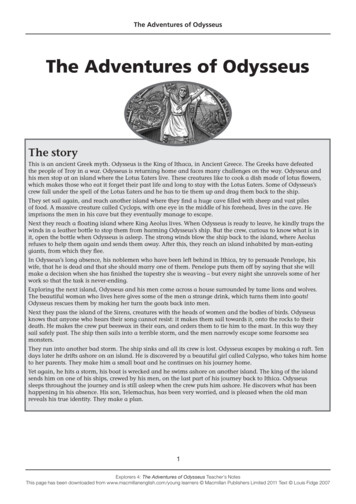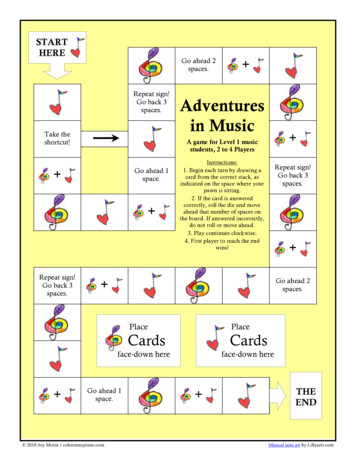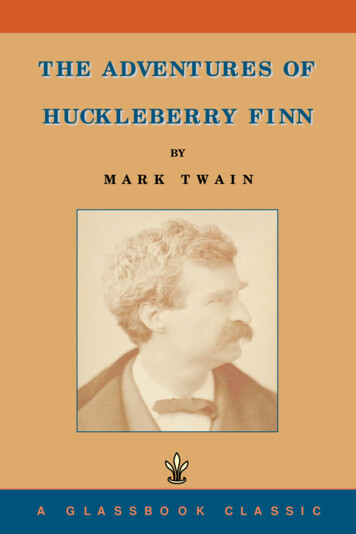
Transcription
The Adventures of OdysseusThe Adventures of OdysseusThe storyThis is an ancient Greek myth. Odysseus is the King of Ithaca, in Ancient Greece. The Greeks have defeatedthe people of Troy in a war. Odysseus is returning home and faces many challenges on the way. Odysseus andhis men stop at an island where the Lotus Eaters live. These creatures like to cook a dish made of lotus flowers,which makes those who eat it forget their past life and long to stay with the Lotus Eaters. Some of Odysseus’screw fall under the spell of the Lotus Eaters and he has to tie them up and drag them back to the ship.They set sail again, and reach another island where they find a huge cave filled with sheep and vast pilesof food. A massive creature called Cyclops, with one eye in the middle of his forehead, lives in the cave. Heimprisons the men in his cave but they eventually manage to escape.Next they reach a floating island where King Aeolus lives. When Odysseus is ready to leave, he kindly traps thewinds in a leather bottle to stop them from harming Odysseus’s ship. But the crew, curious to know what is init, open the bottle when Odysseus is asleep. The strong winds blow the ship back to the island, where Aeolusrefuses to help them again and sends them away. After this, they reach an island inhabited by man-eatinggiants, from which they flee.In Odysseus’s long absence, his noblemen who have been left behind in Ithica, try to persuade Penelope, hiswife, that he is dead and that she should marry one of them. Penelope puts them off by saying that she willmake a decision when she has finished the tapestry she is weaving – but every night she unravels some of herwork so that the task is never-ending.Exploring the next island, Odysseus and his men come across a house surrounded by tame lions and wolves.The beautiful woman who lives here gives some of the men a strange drink, which turns them into goats!Odysseus rescues them by making her turn the goats back into men.Next they pass the island of the Sirens, creatures with the heads of women and the bodies of birds. Odysseusknows that anyone who hears their song cannot resist: it makes them sail towards it, onto the rocks to theirdeath. He makes the crew put beeswax in their ears, and orders them to tie him to the mast. In this way theysail safely past. The ship then sails into a terrible storm, and the men narrowly escape some fearsome seamonsters.They run into another bad storm. The ship sinks and all its crew is lost. Odysseus escapes by making a raft. Tendays later he drifts ashore on an island. He is discovered by a beautiful girl called Calypso, who takes him hometo her parents. They make him a small boat and he continues on his journey home.Yet again, he hits a storm, his boat is wrecked and he swims ashore on another island. The king of the islandsends him on one of his ships, crewed by his men, on the last part of his journey back to Ithica. Odysseussleeps throughout the journey and is still asleep when the crew puts him ashore. He discovers what has beenhappening in his absence. His son, Telemachus, has been very worried, and is pleased when the old manreveals his true identity. They make a plan.1Explorers 4: The Adventures of Odysseus Teacher’s NotesThis page has been downloaded from www.macmillanenglish.com/young learners Macmillan Publishers Limited 2011 Text Louis Fidge 2007
The Adventures of OdysseusNot knowing what he will find at his palace, Odysseus disguises himself as a ragged beggar and joins the feastthat night. After the feast, he and Telemachus remove all the noblemen’s weapons while they sleep. Penelopetells the lazy ‘guests’ that she will marry the man who can shoot an arrow from the bow that Odysseus hasleft behind. The noblemen hold a shooting contest to determine which of them will marry Penelope. Nonesucceeds in firing an arrow accurately from Odysseus’s bow. Then the ‘beggar’ steps forward – and fires a perfectshot. The noblemen realise who he really is and try to attack him – but they find that their weapons havedisappeared. They run away as fast as they can. Odysseus reveals himself to Penelope, and all ends well.Introducing the bookThe title pageThe coverlHold up the cover. Read the book’s title toand with the class. Explain that Odysseus isa person’s name.lTalk about the picture. Ask Is the story set inthe present? How can you tell it happened atsome time in the past? Where do you think ittakes place?lAsk What do you think the story is going to beabout?lAsk the children to turn to the title page.Explain that the story is a legend (an oldstory about imaginary people and events inthe past) and that there are many Greeklegends, most of which are exciting and fullof adventure. Ask Has anyone visited Greece?What do you know about it? (If possible, locateit on a map.) Explain that the story has beenadapted (made simpler).lHold up your own book and point to theman in the centre of the picture. Ask What doyou notice about the way Odysseus is dressed?(He’s wearing a tunic, a cloak, sandals, ametal headband and leather wrist guards.)Do you think he lives in a cold or a hot climate?Why? Draw attention to the rest of thepicture. Ask What do you think is the mainsetting for the story? (the sea).2Explorers 4: The Adventures of Odysseus Teacher’s NotesThis page has been downloaded from www.macmillanenglish.com/young learners Macmillan Publishers Limited 2011 Text Louis Fidge 2007
The Adventures of OdysseuslLook at each part of the picture in turn andtalk about it, starting with the whirlpool andcontinuing in a clockwise direction. Ask Whatis a whirlpool? What is happening to the ship?Does the ship have an engine? (No, it has asingle sail and oars). What does the monsterlook like? How many eyes does it have? How bigdo you think it is? What do you think Odysseus isgoing to do to the monster? What is the flowerlike? Why do you think it might be important inthe story? How many heads does the snakehave? Would you like to come face-to-face withthis snake? What do you think is escaping fromthe bottle to the left of Odysseus? What do younotice about the women on the cliff? (They havethe bodies of birds.) Do you think thesecreatures have any special powers?lPoint out that at the end of the book there is apoem (on page 58) and some facts about TheAncient Greeks (beginning on page 60) andGreece today (beginning on page 62).lDraw attention to the border pictures. Discussand name each of the weapons illustrated.lAsk questions about each chapter title tostimulate the children’s interest, for example:Chapter 1: Why do you think people eat lotusflowers?Chapter 2: Show the title page again andpoint to the one-eyed monster. Ask Wheredoes the monster live?Chapter 3: Show the title page again andpoint to the bottle. Ask What do you think iscoming out of the bottle?lThe contents pageTell the children to do the related activity onpage 1 of their Workbook.Odysseus’s journey (Page 3)lAsk the children to turn to the contents page.Explain that the Contents list tells us what isin the book.lAsk How many chapters are there? Read thechapter titles to and with the class. Brieflyexplain any unfamiliar words (most will becovered in the chapter notes), including thefact that a lotus is a type of flower; Penelopeis the name of Odysseus’s wife and Calypso isthe name of a female character. Ask thechildren what page each chapter starts on.lAsk the children to look at page 3. Read thetext to and with the class. It gives a briefbackground to help the children understandthe story and its setting better. Point outwhere Greece is on the map. Ask the childrento find Troy, where Odysseus begins hisjourney home, and Ithica, his ultimatedestination. (As you read the story, locateany places mentioned on the map.)You can play the story on the audiocassette/CD at any time you choose.3Explorers 4: The Adventures of Odysseus Teacher’s NotesThis page has been downloaded from www.macmillanenglish.com/young learners Macmillan Publishers Limited 2011 Text Louis Fidge 2007
The Adventures of OdysseusChapter 1The Lotus Eatersswordthe ‘w’ is a silent letter and is notpronouncedworriednote how the spelling of thepresent tense worry is changed inthe past tensePages 4 to 6Passive vocabularydraggedlotussailsstrengthBefore readinglPre-teach the active vocabulary (see theTeacher’s Notes Introduction on page 13 andthe Glossary). Use the notes in the table todiscuss any interesting features of the words.lAsk the children to do the activities on page2 of their Workbook to practise the newvocabulary.lRead the title of Chapter 1. Remind thechildren that a lotus is a type of flower. AskWho do you think the Lotus Eaters were? Why doyou think people ate these flowers? Were theflowers magical?lTell the children to look at the picture onpages 4 and 5. Ask What does Odysseus looklike? What is he wearing? Why do you think he iscarrying a sword? What type of flowers do youthink he has found? What are they like? Howmany ships are there in the sea? Why are thesails tied up? What can you see on the beach?What time of day do you think it is? Why? Is thesea calm or rough?lTell the children to look at the picture onpage 6. Ask Why do you think Odysseus ispulling three men behind him? Why do you thinkhe has tied them with a rope? How doesOdysseus look? Is he happy? How do the threemen look? Who do you think the three men are?Where do you think Odysseus is taking them?Where have they come from? What can you seebehind them? What is the fire made of? Who doyou think the people are who are sleeping aroundthe fire?Active vocabularyangrychange the ‘a’ to ‘hu’ and make anew wordbeachrhymes with teach and peachcheerthink of some other ‘ch’ wordsforgeta compound word: for get forgetfriendlythe ‘i’ is not pronounced – wepronounce the word as ‘frendly’islandremember that: an island is landsurrounded by water!sailorother ‘or’ words which indicate jobsare: author, doctor, tailorstraightother ‘str’ words include: string,strong, strange, stretch, stream,street4Explorers 4: The Adventures of Odysseus Teacher’s NotesThis page has been downloaded from www.macmillanenglish.com/young learners Macmillan Publishers Limited 2011 Text Louis Fidge 2007
The Adventures of Odysseusl3Why did the ships stop at the small island?4Did two or three men set off to look forwater?5What did Odysseus take with him when hewent to look for the three men?6What sort of flowers did Odysseus see?7Were the Lotus Eaters friendly or fierce?Read the chapter expressively to the class (orplay the audio cassette/CD). Do not stop toexplain anything or to ask questions. Ensurethe children are following in their books.8What happened when you ate food madefrom lotus flowers?9The fire that Odysseus saw was orange – trueor false?Choose whichever of the following options ismost appropriate for your class:10 How many Lotus Eaters were there near thefire?– Read the chapter again and encourage theclass to read it with you.11 Were they wide awake or sleepy?Optional suggestion: you may wish to givethe children an appropriate amount of time,for example five minutes, to look quicklythrough the chapter to find (and perhapsunderline) the active vocabulary they havebeen introduced to.During readingll12 What did Odysseus tell his three sailors todo?– Read the chapter again, a paragraph at atime, and ask the class (or individuals) toread each paragraph aloud after you.13 Why didn’t the sailor remember whoOdysseus was?– Do not read again yourself. Ask groups orindividuals to read the chapter aloud, aparagraph at a time.lRead (or play) the chapter again, aparagraph at a time. Explain the meaningand pronunciation of the words listed aspassive vocabulary, and any otherunfamiliar words.lDiscuss how the pictures can help the readerguess the meaning of the text.14 Was Odysseus angry or happy?15 Where did Odysseus take the three sailors?Stage 1 comprehension (literal)Ask these questions orally, or set them asa written activity. You can also ask thechildren to do the activities on page 3 of theirWorkbook.1How many ships sailed away from Troy?2Where was Odysseus’s home?lAsk the children to find examples ofquestions and exclamations in the chapter.Draw attention to their punctuation. Readeach one aloud, and draw attention to howyour tone of voice changes.lAsk the children to find and read aloud anywords containing ‘ee’, ‘ea’, ‘oo’, or ‘ow’.lFinally, ask individuals to re-read shortsections of the text aloud. Encourage them toread expressively and with appropriateintonation. (You might like to ask children toplay the role of particular characters andread their parts.)5Explorers 4: The Adventures of Odysseus Teacher’s NotesThis page has been downloaded from www.macmillanenglish.com/young learners Macmillan Publishers Limited 2011 Text Louis Fidge 2007
The Adventures of OdysseusAfter readinglAsk What did the sailors do when they startedtheir journey home? (They cheered.) Discussoccasions when people cheer. Does a cheernormally indicate happiness or sadness?lDiscuss what it would be like to lose yourmemory and what problems this wouldcause.lWrite some of the words from the chapter onthe board and ‘forget’ to put in the vowels.Leave spaces for them, for example s l d(sailed). Ask the children to supply themissing vowels. (You could ask the class tocheer when someone supplies the correctanswer to each spelling.)lPlay a rhyming game. Write these wordsfrom the chapter on the board: soon, small,stop, beach, see, look, right, land. Brainstormas a class, and write on the board, as manywords that rhyme with each word as possible(for example, soon: balloon/June/moon/spoon).lElicit from the class the names of any flowersthey know. Do a quick survey to find outwhat the children’s favourite flower is.Discuss when we give flowers to people.lIf appropriate, try some Extension Activities(see the Teacher’s Notes Introduction page19).lAsk What do you think will happen next in thestory?Stage 2 comprehension (extension)Ask these questions orally, or set them as awritten activity for the more able. Answerswill vary. Encourage the children to givereasons for their suggestions, and accept anyanswer they can justify.1Do you think Odysseus was pleased to begoing home? Why?2How can you tell his men were happy?3Why do you think Odysseus decided to stopat the small island for water?4Why did the sailors take down the sails fromtheir ships?5How can you tell that it was late in the day?6Why do you think Odysseus was worriedwhen his three men did not return?7How did Odysseus know the flowers werelotus flowers?8What was the problem when you ate lotusflowers?9Was the fire on the beach or in the forest?How do you know?10 Do you think Odysseus was scared of theLotus Eaters when he saw them?11 Why do you think the first sailor askedOdysseus who he was when he woke up?12 Why do you think this made Odysseusangry?13 How can you tell Odysseus was very strong?14 Why did Odysseus decide to leave the islandstraight away?15 Do you think the three sailors ever got theirmemories back?6Explorers 4: The Adventures of Odysseus Teacher’s NotesThis page has been downloaded from www.macmillanenglish.com/young learners Macmillan Publishers Limited 2011 Text Louis Fidge 2007
The Adventures of OdysseusChapter 2A monster in a cavedragsome other ‘dr’ words are: drum,drop, drinkhugenote how the pronunciation of hugis changed by the addition of ‘e’Pages 7 to 11hungrythe ‘y’ at the end of hungry andthirsty sounds like ‘ee’monsterthink of words beginning or endingwith ‘st’snorechange the ‘sn’ to ‘c’, ‘m’, ‘st’, ‘sh’to make some new wordsthirstythundercontains a ‘hidden’ preposition(under)Passive dewoolyelledBefore readingActive vocabularyblindchange the ‘bl’ to ‘k’ to makeanother wordbranchsome other ‘br’ words are: broom,brick, bringcaverhyming words include: save, wave,gave, shavelPre-teach the active vocabulary (see theTeacher’s Notes Introduction on page 13 andthe Glossary). Use the notes in the table todiscuss any interesting features of the words.lAsk the children to do the activities on page4 of their Workbook to practise the newvocabulary.lAsk the class to recall what happened in theprevious chapter.lRead the title of Chapter 2. Remind thechildren of the one-eyed monster on the titlepage and tell them that this is the monsterthat lives in the cave. Ask Would you be afraidof this monster? Would you run away?lTell the children to look at the picture onpage 7. Ask Where is the cave? How many menare outside it? Why do you think the men aregoing towards the cave? Do you think the menknow what is in the cave? Why is it difficult tosee inside the cave? What are the men carrying?7Explorers 4: The Adventures of Odysseus Teacher’s NotesThis page has been downloaded from www.macmillanenglish.com/young learners Macmillan Publishers Limited 2011 Text Louis Fidge 2007
The Adventures of OdysseuslllTell the children to look at the picture onpages 8 and 9. Ask Where is this? Is it a largecave? How big is the monster? What does it looklike? Does it look friendly or fierce? What do youthink it is thinking? Do you think it has made afire to keep warm or to cook something? Whatanimals are in the cave? Are they lying down orstanding up? Who do you think they belong to?Why do you think they are there? Where areOdysseus and his men? What do you think themonster is going to do next?How many men altogether went to look forfood and water?4Where was the cave?8Why did Odysseus want to stay in the cave?9What happened as night fell?15 The monster was a Cyclops – true or false?16 The monster said, ‘I will not help Greeksailors – but I will them!’17 What were the monster’s teeth like?18 What did Odysseus do with the burningbranch that he picked up from the fire?19 What did the Cyclops’ voice sound like whenit yelled?20 Why couldn’t the sailors leave the cave?21 Why did Cyclops go to sleep again?22 What did the monster yell when it woke up?23 Why did Cyclops drag the rock away fromthe mouth of the cave?24 What did Cyclops do as the sheep ran out ofthe cave?25 How did Odysseus and his men get out of thecave?Ask these questions orally, or set them asa written activity. You can also ask thechildren to do the activity on page 5 of theirWorkbook.3What did the men eat?14 Describe the monster.Stage 1 comprehension (literal)What did they see in the morning?713 What did it yell at Odysseus?Read the chapter to and with the class.Follow the same procedure as you did forChapter 1 (see page 5) to help the childrenread and understand the text. Use the audiocassette/CD, if you wish.2The men also found lots of in the cave.12 What two things did the monster do before itsaw Odysseus?Optional suggestion: you may wish to givethe children an appropriate amount of time,for example five minutes, to look quicklythrough the chapter to find the activevocabulary they have been introduced to.At what time of day did they arrive at thenext island?611 What were the monster’s feet like?Tell the children to look at the picture onpages 10 and 11. Ask Where do you think thesheep are going? What’s under each sheep? Whydo you think this is? Do you think the sheep areinside or outside the cave? Where do you thinkthe monster is?1What did they see in the cave – sheep orgoats?10 What came into the cave?During readingl5lFind examples of people speaking in the text.Draw attention to the speech marks anddiscuss how they are used. In each case, askthe children what the exact words were thatwere spoken by the person. Elicit that theseare the words that go inside the speechmarks.8Explorers 4: The Adventures of Odysseus Teacher’s NotesThis page has been downloaded from www.macmillanenglish.com/young learners Macmillan Publishers Limited 2011 Text Louis Fidge 2007
The Adventures of OdysseuslllDraw attention to the way the words on page8 are written to show that Odysseus is scaredwhen he is talking to the monster (letters arerepeated to indicate stuttering).4Why didn’t the monster see Odysseus and hismen at first?5Why do you think the monster dragged ahuge rock across the mouth of the cave?Draw attention to the way the words Crash!and will on page 8 are written (they are initalics). Re-read the sentences and explainthat it means we should emphasise themwhen reading them.6Why do you think the monster was angrywhen it saw Odysseus?7How can you tell that Odysseus wasfrightened when he spoke to Cyclops?8Why couldn’t Odysseus and his men get outof the cave while Cyclops was asleep?9How could Odysseus tell the Cyclops wasasleep?Ask the children to find and read any twosyllable words in the text. As they read them,ask them to tap out the syllables as they doso (for example, thir-sty).lAsk children to find and read any wordscontaining a double consonant (for example,arrived, hillside, suddenly).10 Do you think Odysseus was brave or foolishto attack the Cyclops with the burningbranch?lAsk the children to find and read aloud anyverbs which end with ‘ed’ (the suffix whichindicates that the verb has a ‘regular’ pasttense).11 How can you tell the Cyclops could not seewhen it jumped up?l12 How can you tell the Cyclops chasedOdysseus and his men around the cave for along time?Finally, ask individuals to re-read shortsections of the text aloud. Encourage them toread expressively and with appropriateintonation. (You might like to ask children toplay the role of particular characters andread their parts.)13 How did the Cyclops feel when it woke upblind, in the morning?14 Why do you think Odysseus told the sailornot to speak?15 Why did the Cyclops want to let his sheepout of the cave?After reading16 How did the Cyclops know how many sheepwent out of the cave?Stage 2 comprehension (extension)17 What did you think of Odysseus’s plan to getout of the cave?Ask these questions orally, or set them as awritten activity for the more able. Answerswill vary. Encourage the children to givereasons for their suggestions, and accept anyanswer they can justify.1Do you think Odysseus was sensible to gointo the dark cave?2Why did the hillside start to shake?3How do you think Odysseus felt when he sawthe monster?lAsk the class if they know any animals thatlive in caves. Discuss the advantages of livingin a cave.lAsk the children to tell you anything theyknow about sheep.9Explorers 4: The Adventures of Odysseus Teacher’s NotesThis page has been downloaded from www.macmillanenglish.com/young learners Macmillan Publishers Limited 2011 Text Louis Fidge 2007
The Adventures of OdysseuslWrite the words good and food on the boardand say them. Point out that the sound ofthe ‘oo’ is short in good and long in food.Write the words head and eat on the board.Point out that the sound of the ‘ea’ is short inhead and long in eat. Explain that the sameletter patterns are not always pronouncedthe same.lWrite the words cornfield and hillside on theboard and show how each word is made oftwo separate words: corn and field, hill andside. Explain that these words are calledcompound words.llPlay the opposites game. Write the followingwords from the story on the board: night, big,into, back, eat, hungry, friend, yelled, asleep,ran. Divide the class into two teams. Explainthat you will read out some words and eachtime they must decide what the opposite ofeach word is. Say each word in turn, allow ashort time for the teams to discuss theiranswer, then select one person from eachteam to give you their team’s answer. Awarda point for each correct answer. The teamwith most points wins.lDiscuss what it would be like to be blind.Play a game to demonstrate the problems ofblindness. Put a few chairs at the front of theroom. Invite two children to the front. Tie ablindfold (a piece of material) around onechild’s eyes. The partner must then ‘guide’the blindfolded child from one side of theroom to the other using words only, withoutthe blindfolded child walking into any of thechairs.lAsk the children if they think it was right forOdysseus and his men to go into the caveand take the food that belonged to theCyclops.lDiscuss some of the possible dangers ofweapons like swords and sharp knives.lIf appropriate, try some Extension Activities(see the Teacher’s Notes Introduction page19).lAsk What do you think will happen next in thestory?Write the words Cyclops, face and voice on theboard and read them. Discuss what soundthe ‘c’ in each makes. Explain that when ‘c’is followed by ‘e’, ‘i’ or ‘y’ it sounds like ‘s’and that we call this a soft ‘c’ sound. Nowwrite these words on the board: city, centre,icy, cinema, dance, difference, fence. Ask thechildren to read them.10Explorers 4: The Adventures of Odysseus Teacher’s NotesThis page has been downloaded from www.macmillanenglish.com/young learners Macmillan Publishers Limited 2011 Text Louis Fidge 2007
The Adventures of OdysseusChapter 3Wind in a bottlewifePages 12 to 15batteredthe plural of wife is wives – notethe changesPassive vocabularyrushedBefore readinglPre-teach the active vocabulary (see theTeacher’s Notes Introduction on page 13 andthe Glossary). Use the notes in the table todiscuss any interesting features of the words.lAsk the children to do the activity on page 6of their Workbook to practise the newvocabulary.lAsk the class to recall what happened in theprevious chapter.lRead the title of Chapter 3. Ask What do youthink the chapter is going to be about? Tell thechildren to look back at the title page. AskDoes the title now explain what the ‘smoke’ isthat is coming out of the bottle? Why wouldthere be wind in a bottle? Who could have put itthere and why?lTell the children to look at the picture onpages 12 and 13. Ask Who is Odysseus talkingto? Does the man look important? How is hedressed? What animal does he make you thinkof? What do you think the two men arediscussing? Where are they? Who do you thinkall the other men at the table are? What foodand drink can you see on the table? Where is thefeast taking place? Whose palace do you think itis?lTell the children to look at the picture onpages 14 and 15. Ask Can you guess now whatis coming out of the bottle? Who opened thebottle? How do the two men look? Why do themen look scared? Do you think the men can seethe wind? Do you think they can hear the wind?What sort of noise do they think the wind ismaking?Active vocabularyadventurethe ‘ture’ is pronounced ‘cher’cheekschange the ‘ks’ to ‘se’ and see whatfood you makeescapeadd ‘e’ to ‘cap’ and make anotherwordexhaustedthe ‘h’ is a silent letter and is notpronouncedfloatother ‘oa’ words are: boat, coat,soap, road, cloak, loaf, coastgoldenwe add ‘en’ to change the noungold into the adjective goldenleatherrhymes with weathermightythe ‘igh’ is pronounced as a long ‘i’soundpalaceremove the first ‘a’ and makeanother word11Explorers 4: The Adventures of Odysseus Teacher’s NotesThis page has been downloaded from www.macmillanenglish.com/young learners Macmillan Publishers Limited 2011 Text Louis Fidge 2007
The Adventures of Odysseusl13 Where did the winds blow the ships back to?Optional suggestion: you may wish to givethe children an appropriate amount of time,for example five minutes, to look quicklythrough the chapter to find the activevocabulary they have been introduced to.14 Was the king happy or angry to seeOdysseus?15 What did he say to Odysseus?lAsk the children to find some commas in thetext. Discuss their purpose. Remind childrenthat they tell the reader to pause briefly, tohelp you make more sense of the sentence.Read a few sentences again to demonstrate.lDraw attention to the way the word not iswritten on page 15 (it is in italics). Re-readthe sentence and explain that it means weshould emphasise it when reading it.lThere are several examples in Chapter 3 ofcompound sentences which are joined usingthe conjunction and. Find and read some ofthese sentences out loud and discuss howthey consist of two short sentences joined bythe conjunction and, for example Odysseusand his men ran back to their ships. They set offagain. become Odysseus and his men ran backto their ships and set off again.lFind some adjectives in the text and discusshow they describe a particular noun and tellus more about it, for example a goldenpalace, a tall man, a leather bottle.l10 Which wind did the king NOT put in thebottle?Find ‘time marker’ words or phrases in thetext and discuss how they indicate thepassing of time in the story, for examplebefore long, for many days, each night, one day,a long time, the next morning, that night, andby the time.l11 What did one of Odysseus’s men think thebottle contained?Ask the children to find and read any wordsof more than eight letters in the chapter.lFinally, ask individuals to re-read shortsections of the text aloud. Encourage them toread expressively and with appropriateintonation. (You might like to ask children toplay the role of particular characters andread their parts.)During readinglRead the chapter to and with the class.Follow the same procedure as you did forChapter 1 (see page 5) to help the childrenread and understand the text. Use the audiocassette/CD, if you wish.Stage 1 comprehension (literal)Ask these questions orally, or set them asa written activity. You can also ask thechildren to do the activity on page 7 of theirWorkbook.1The island Odysseus and his men came to,seemed to float above the .2What did Odysseus and his men walktowards when they got off their ships?3Who came to the door of the palace?4What did King Aeolus look like?5Did Odysseus stay in the palace for a fewdays or for many days?6Who was Penelope?7Odysseus said that he had not seen his wifefor a long time – true or false?8What did the king put into a bottle? Why?9Was it a glass bottle or a leather bottle?12 What happened as soon as the bottle wasopen?12Explorers 4: The Adventures of Odysseus Teacher’s NotesThis page has been downloaded from www.macmillanenglish.com/young learners Macmillan Publishers Limited 2011 Text Louis Fidge 2007
sail safely past. The ship then sails into a terrible storm, and the men narrowly escape some fearsome sea monsters. They run into another bad storm. The ship sinks and all its crew is lost. Odysseus escapes by making a raft. Ten days later he drifts ashore on an island. He is discover










